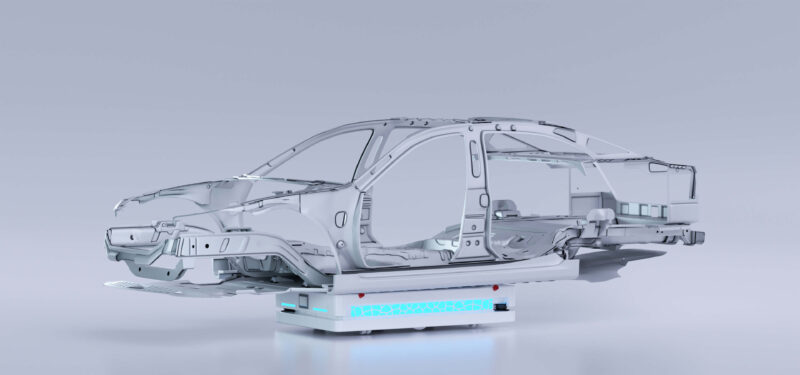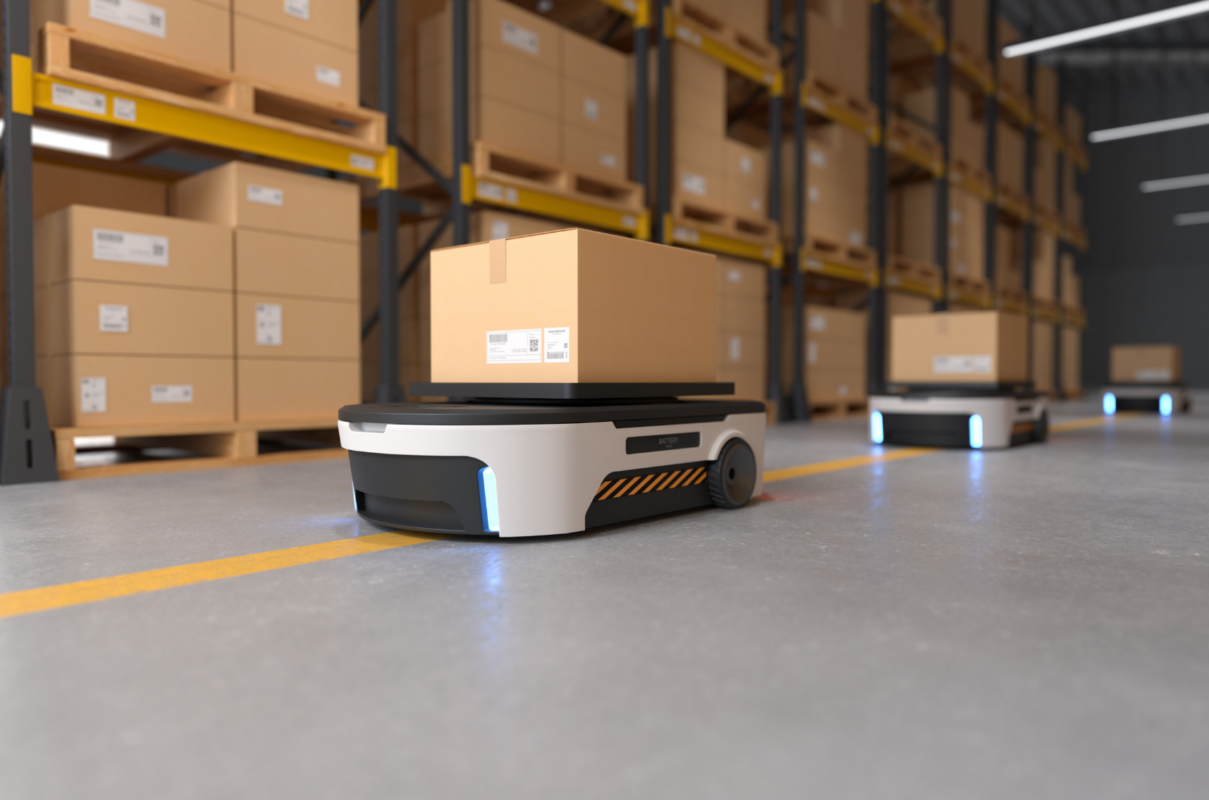At the Motek & Vision 2022 trade fair in Stuttgart, AMRs caught our attention. We were impressed and wanted to learn more about these robots. AMRs are gaining popularity in various fields like farms, hospitals, warehouses, and delivery services because they help you work smarter and safer. In this blog, we’ll explain what AMRs are, how they function, and how they can benefit your business.
Let’s dive in and see how AMRs can make a difference for you.
What are Autonomous Mobile Robots (AMRs)?
Autonomous Mobile Robots (AMRs) are machines that move on their own using sensors and computers. They don’t need fixed paths like traditional robots. Instead, they use AI to understand their surroundings and find the best way to get to their destination.
AMRs come with wheels, legs, or other tools to help them move. They’re often used to carry materials or products in factories and warehouses. By automating these tasks, you make your operations more efficient and flexible.
Where Can You Use AMRs?
You can use AMRs in places like warehouses, hospitals, or retail stores. They handle simple tasks such as moving stock, delivering items, or assisting with daily operations. This lets your team focus on more important work while improving productivity and cutting costs.
How do AMRs work?
Navigation & Mapping:
AMRs use sensors like cameras and LiDAR to scan their environment. They create a map of their surroundings, detecting obstacles and planning their route. This helps them avoid collisions and navigate effectively.
Real-Time Decision Making:
AMRs have onboard computers that process sensor data. They use AI to make decisions quickly, adjusting their path if they encounter new obstacles or changes in their environment.
Movement & Control:
AMRs are fitted with wheels, tracks, or legs for movement. The control system directs these parts to follow the planned route accurately, ensuring smooth operation. You can also set them up to handle specific tasks or follow certain paths.
Communication:
AMRs stay connected with your facility’s systems. They send status updates and receive instructions, helping them fit seamlessly into your workflow and boost overall efficiency.

Han’s Robots has a smart robot called HR Mobile Robot. It’s like a helpful assistant in big buildings. It can carry things safely and go around without hitting things.
This robot is super quick to recharge, so it doesn’t stop working for a long time. It’s good for factories and other big places where they need to move stuff around. It keeps things safe and doesn’t bump into things. It’s really handy for making work faster and easier.
What is the Difference Between an AGV & an AMR?
Navigation:
AGVs (Automated Guided Vehicles) follow fixed paths using tracks or magnetic strips. They stay on these set routes and cannot change them. AMRs (Autonomous Mobile Robots) use sensors and AI to map their surroundings. They navigate freely and avoid obstacles, giving you more flexibility.
Flexibility:
AGVs are less flexible because they rely on fixed paths. If you need to change the route, you must adjust the guiding system. AMRs can adapt on the fly, changing routes and handling obstacles as they move, which suits more dynamic environments.
Technology:
AGVs use basic technology to follow guides and navigate. AMRs have advanced sensors, cameras, and AI. This allows them to make real-time decisions and adapt to their surroundings.
Applications:
AGVs are ideal for repetitive tasks in stable environments. AMRs work well in more dynamic settings where you need flexibility and adaptability.
How Different Industries Use AMRs?
Warehousing & Distribution:
In your warehouse, AMRs can move goods between storage areas and shipping docks. They handle tasks like transporting pallets and restocking shelves, which cuts down on manual labor and boosts efficiency. You can set them to follow specific paths or adjust their routes based on inventory changes, keeping your operations smooth.
Manufacturing:
AMRs in manufacturing transport materials to and from production lines. They deliver raw materials, move finished products, and can even assist with quality checks. Their ability to navigate complex layouts helps you streamline your production processes and handle various tasks more efficiently.
Healthcare:
In hospitals, AMRs deliver medications, supplies, and clean linen. They move through the facility, freeing up staff from these tasks. This helps you ensure timely deliveries and keep your environment organized and efficient.
Retail:
Retail stores use AMRs to restock shelves and manage inventory. They move products around the store, helping you keep shelves stocked and maintain good product availability for your customers.
Logistics:
In logistics, AMRs optimize how goods move within distribution centers. They transport items, sort packages, and support order fulfillment. This reduces delays and speeds up your distribution process, making your supply chain more efficient.
By integrating AMRs into your operations, you improve efficiency, cut labor costs, and boost overall productivity in various settings.
Benefits of Using AMRs in Your Factory:
Boosted Efficiency:
AMRs automate material transport in your factory. They move goods between production lines and storage, cutting down on manual labor. This speeds up your processes and helps you meet your production goals faster.
Greater Flexibility:
AMRs adapt to changes in your factory layout. They use sensors and AI to navigate around obstacles and adjust their routes. This means they can handle various tasks and changes without needing major adjustments, giving you more flexibility.
Enhanced Safety:
AMRs reduce the need for employees to work in risky areas, like high-traffic zones or near heavy equipment. By handling these tasks, AMRs lower the chance of accidents and make your workplace safer.
Cost Savings:
Using AMRs can save you money. They cut labor costs by taking over repetitive tasks and minimize material waste with precise handling. Their efficiency also boosts production, helping you get more from your resources.
Improved Accuracy:
AMRs handle materials and manage inventory with high precision. This reduces errors and ensures your goods are transported correctly, leading to better quality and fewer mistakes.
Overall, AMRs help you improve efficiency, flexibility, safety, cost-effectiveness, and accuracy in your factory, making your operations smoother and more productive.
Why Investing in AMRs is Beneficial for Your Operations:
Boosted Productivity:
When you invest in AMRs, you speed up your operations. They handle repetitive tasks like moving materials and transporting goods, freeing up your team to focus on more complex work. This leads to greater overall efficiency.
Cost Savings:
AMRs help you cut labor costs by automating routine tasks that would otherwise need manual effort. They also reduce material waste with precise handling. These savings add up over time, making AMRs a smart financial choice.
Greater Flexibility:
AMRs adapt easily to changes in your factory layout and workflow. They can take on various tasks and adjust their routes as needed. This flexibility lets you quickly respond to new demands or changes without major disruptions.
Enhanced Safety:
AMRs handle tasks in risky areas, reducing the chance of accidents for your employees. By taking over dangerous or repetitive jobs, they make your work environment safer and help prevent injuries.
Improved Accuracy:
AMRs provide precise material handling and inventory management. They reduce errors in moving goods and tracking stock levels. This leads to higher quality results and fewer mistakes in your operations.
Need Free Advice For Your Robot Project?
Conclusion:
If you think AMRs could benefit your business, they might be a great investment. Your decision will depend on your specific needs and goals. To find the best solution, consult with a systems integrator who can offer tailored advice and a detailed analysis. This will help you choose the right AMR for your operations and ensure it meets your needs.







I’m really impressed with your writing skills as well as with the layout on your weblog. Is this a paid theme or did you customize it yourself? Either way keep up the excellent quality writing, it’s rare to see a nice blog like this one nowadays.
Thanks for sharing such a unique and useful article, it’s great.
Your post was very educational. It would be interesting to see a follow-up article on how industrial sensors are being used in Industry 4.0 environments.
Your article does a great job illustrating the variety of sensors used across different applications in robotics. I’m especially interested in how the choice of sensors can vary based on the task—like comparing industrial robots to service robots.
Excellent overview of AMRs—really puts into perspective how fast automation is moving forward.Proact, founded in 2001 and based in Bengaluru, is a leading force in high-tech industries like aerospace, aviation, electronics, defense, and more. Renowned for innovation and excellence, Proact offers tailored solutions to diverse challenges, making it a trusted partner for businesses. Explore cutting-edge services and products at https://www.proact-ims.com/ or contact us at +91 80 3542 9949 for collaboration and innovation opportunities. Elevate your projects with Proact’s expertise.
Allows customers to explore cars in AR: try different specs/colors, “see” the car in their driveway virtually, or take virtual test drives.explore cutting-edge services and products at https://www.proact-ims.com/ or contact us at +91 80 3542 9949 for collaboration and innovation opportunities. Elevate your projects with Proact’s expertise.